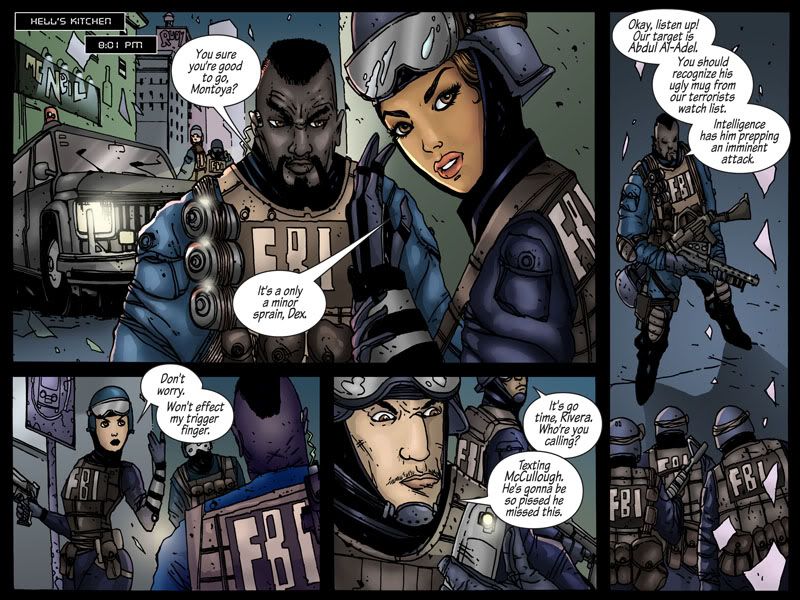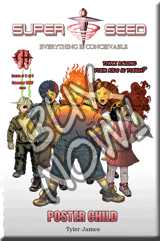 Back again, with the eighth installment of my ten-part series on writing process. In case you missed any of the previous installments, here are quick links to them in reverse chronological order. How generous of me, no?
Back again, with the eighth installment of my ten-part series on writing process. In case you missed any of the previous installments, here are quick links to them in reverse chronological order. How generous of me, no?
- My Writing Process Part VII: Memorable Scenes
- My Writing Process Part VI: Beat It
- My Writing Process Part V: Structurally Sound
- My Writing Process Part IV: Characters That Make You Give a Damn
- My Writing Process Part III: The Killer Pitch
- My Writing Process Part II: Research is Key
- My Writing Process Part I: The Great Idea
Well, that's enough dwelling in the past. Let's get on with the new and exciting.
VIII. Sharp Dialogue
I'm going to come right out and say it at the top, because it deserves to be said: Writing great dialogue is extremely difficult. Sure, there are your David Mamets and Quentin Tarrantinos in film, and your Brian Bendises in comics. These are writers incredibly gifted at putting words in their characters' mouths. And while these masters of their respective crafts should certainly be studied, imitate them at their own peril. For there is a second statement that needs to be said: Writing bad dialogue is very easy. Hell, after Pulp Fiction came out, every new writer on the block was writing scenes with tough characters waxing poetic and riffing on pop culture...and it was ugly. Likewise, a disciple of Bendis runs the risk of writing a talking heads book, which is not something an aspiring creator should try to do.
No, let those creators do what they do best. What I'm going to say here is this: Don't strive to write great dialogue. Going for great with dialogue writing will probably make it look like you're trying to hard. For now, good is good enough. So I'm going to give you a number of rules that if you follow, your dialogue will, in fact, be good. What do I mean by good? I mean you'll write dialogue that at worst won't hurt your story and at best will help it a great deal.
And you want to know the best part? If you write good dialogue long enough and consistently enough...well, that's a great thing, a thing very few aspiring writers are capable of. And pretty soon, guess what word they're going to start using to describe your dialogue? Great.
Rule #1: Dialogue has a function!
Your job as a writer for visual media is not to put words in characters' mouths just for the sake of filling in those word balloons. Every piece of dialogue you script should have a function. What function? Well, here's a primer from Syd Field. What follows are all the functions dialogue can and should have in your scripts.
Dialogue should...
...Move the story forward.
...Communicate facts and information to the reader.
...Reveal character.
...Establish character relationships.
...Make your characters real, natural, and spontaneous.
...Reveal the conflicts of the story and characters.
...Reveal the emotional states of your characters.
...Comment on the action.
...Foreshadow future action or events.
That's the list. Stick to it. Often times, good dialogue will perform several of those functions at once. Here's a page from my comic CounterTERROR that I feel has good dialogue. (Genius? Certainly not. But it is solid.)
How many functions does the dialogue on this page satisfy?
1.) Moves the story forward- The previous scene was 15 minutes earlier and ended with a National Counterterrorism director contacting the New York FBI SWAT team. Now we've jumped ahead in time, and the dialogue establishes that the team is assembled and ready to move.
2.) Communicates facts and information to the reader- Here we find out a little more about their target.
3.) Reveals character- Montoya in particular. She's got a sprained left hand, but still cocky and ready to roll. That bravado will come to play throughout the story.
4.) Establish character relationships- The easy way Montoya and Dexter Mason interact suggests a closeness. This is a cohesive team. Also, Rivera texting McCullough, who is actually the story's main protagonist, introduces that character as a missing part of the team.
5.) Foreshadow future action or events- I needed to call out the brace on Montoya's left hand through dialogue, because I'm not sure it would have been noticed in the art. This is important, because that brace is going to save her life shortly.
So you see, I didn't just fill in word balloons. All the dialogue on this page serves one or more functions. Not bad, huh?
Rule #2: Don't write dialogue until your story is finished
What? What do you mean, Ty? How the hell am I supposed to finish my story if I don't write dialogue? Here me out. On this point, I have the great Alfred Hitchcock to back me up. Hitchcock once said, "When the screenplay has been written, and the dialogue added, we're ready to shoot." When writing for visual mediums like film and comics, nailing the imagery should be your primary task. Filling in those word balloons should be a secondary concern.
Think about it. If you were given a comic book with all the words removed, could you still follow the story? In most cases, sure. And if asked, you could probably add in words of your own and tell a halfway decent story yourself. How many movies can you follow with the sound turned off? Sure, they're not nearly as compelling, but you can still follow the action in most cases. You know who the good guy is, and often, you can figure out what he wants and what's standing in his way...all without hearing the dialogue. Even David Mamet, reknowned wordsmith though he may be, recognized this. "The story is being carried by the shots. Basically, the perfect movie doesn't have any dialogue," he said.
Now, please don't go out and write a dialogue free script. But definitely do consider the point, that the imagery and action in your story needs to be mapped out before you should be concerned with dialogue. McKee suggests, "The wise writer puts off writing dialogue for as long as possible, because the premature writing of dialogue chokes creativity." If you fall in love with bits of dialogue before you've had time to fall in love with your characters, or even know what happens to them in the story, this can hinder organic developments in the writing. Forcing words into your still developing characters mouths will stunt their growth. So the general rule is to figure out your story and your story people before you start making them talk.
Rule #3: It's okay if it sucks...at first.
When you first get rolling on the writing of your scripts, your dialogue probably isn't going to be very good. No, this statement isn't meant to discourage. Quite the opposite. I'm giving you permission to stink it up for a while. See, the first 10-30 pages of your script, you're still getting to know your characters, and it's going to take a while before you fully get a handle on how they speak and act. And that's perfectly fine. Your first crack at dialogue will likely be uneven and cliched, and will be difficult to plow through.
But plow through you must. Just keep writing. Now, what you want to do when writing your first draft is just steadfastly move your story forward. Again, you want to do this regardless of the verbal diarrhea spilling from your characters' lips. If you have to toss in awful catch phrases like, "Lock and load!" to convey confidence and ready for action, throw it in and keep going. (But good God remember to change it later!) Trust that writing dialogue will get easier, not harder, as you continue to write and become more familiar with the characters you've created.
As I mentioned in the last article on Memorable Scenes, content follows context. Sometimes writing the actual content of the dialogue (what is actually said, the words actually spoken) are difficult to craft, and risk holding up the writing. So, you know what? Just fill in something, anything, that speaks to the context (the purpose of the scene, the story moving impact of the conversation) and continue. As long as the context is strong and that story beat important, the story will stay solid. You can always go back and fix the dialogue in a later rewrite.
Rule #4: In these tough times, write economically.
You will write too much dialogue.
Trust me. You will. Writers like to write, and the words they put in their characters' mouths always seem like the most important words they write on a page. While action or panel descriptions are important, the dialogue and captions are the only words you write that the readers will actually get to see. As a result, many rookie writers tend to write way too many of them.
While writing economically is a central tenet of good screenwriting, it's even more important when writing for comics. In movies, fast talkers can squeeze in words, and a brilliant oratory performance can cover up wordiness to some extent. But in comics, every word you write actually has to fit somewhere on the page. For comic writers, just trust me and follow the Alan Moore 35, 25, 120 rule I've mentioned before:
- No more than 35 words per panel.
- No more than 25 words per word balloon or caption.
- No more than 120 words on a page.
As David Gallaher, writer of High Moon, shared with me, "The sad thing is...comics readers today don't love to read." David tries to fill his balloons with 15 words or less, and is a definite subscriber to the less is more philosophy of writing. Hell, he recently opened Season III with 4 completely wordless pages. (Note, this strategy is usually only effective when you're working with an artist as talented as High MoonHigh Moon's Steve Ellis.) But really consider the necessity of the words you put on a page. Remember, the more words you have, the more art you're going to cover. Artists work too damn hard to have their work covered with fluff. So be economical, and make every word count.
Rule #5: Write with subtext, not "on the nose."
One of the most common critiques of novice writers is that their writing is "too on the nose." This seemingly catchall phrase for bad writing describes dialogue that feels forced or unrealistic because it carries information the writer wants the audience to know, that is said in a way a character would not actually say it at the time being delivered.
Want a simple "on the nose" check? When one of your characters verbalizes EXACTLY what they're feeling, 9 times out of 10, it's going to sound "on the nose."
Wait? So my characters shouldn't say what they're feeling? Should they say the opposite? Not exactly. Here's where subtext comes in. Give us humans some credit. We have a tremendous ability to get what we want or convey our desires or intentions without actually saying them aloud.
Here's an example. Like a girl? You could try walking up to her directly and saying, "I find you extremely attractive. I find myself fantasizing about what you must look like naked. I would really like to invite you to my bed. Boobs."
Hey, I'm no pick-up expert. Give it a try and get back to me. (Note: Ladies, this approach might actually work with guys. Be "on the nose" with us all you like.) Kidding aside, this isn't how we do things. Instead, we'll strike up conversation about something completely unrelated to hopping in the sack. We'll invite the girl out for "drinks" or "a movie" or fire off a "Going out tonight?" text. And the funny thing about subtext, is that by not directly talking about what it is we want (sex, companionship, etc.) we are increasing the likelihood that we'll actually get it.
And it's the same with your writing. The more you can intimate what your characters think and feel BY NOT writing exactly what they think and feel, the sharper your dialogue is going to be. Clever dialogue is full of inference, intimation and innuendo. Your audience is smart, and a good approach is to always write as if your audience is just a little be smarter than you are. You don't need to beat them over the head with your point to make it. The days of the cliched, overwritten comic book dialogue are [hopefully] over.
Here's a very short snippet of a rewrite I did on my screenplay that will illustrate some of the points I'm making here.
First Draft
INT. STRIP CLUB
FELIX sits in a dingy, nearly empty club, drinking a beer and hardly watching a STRIPPER in her early 40's gyrate on her knees in front of him.
STRIPPER
Why the long face, handsome?
FELIX
I miss my girlfriend.
STRIPPER
Making men forget about their
girlfriends is my specialty, honey.
Re-written Version
INT. STRIP CLUB - NIGHT
FELIX sits in a dingy, nearly empty club, drinking a beer and hardly watching a STRIPPER in her early 40's gyrate on herknees in front of him.
STRIPPER
Why the sad mug, handsome?
FELIX
You're wearing her perfume.
STRIPPER
Makin'em forget about their
girlfriends is my specialty, sugar.
Note, there were a couple small changes to the dialogue made from first draft to latest draft in this short snippet of a scene. I changed, "Why the long face" to "Why the sad mug," just because the first sounded too much like the punchline of a bad joke. But really what I wanted to point out was Felix's line change. What is Felix feeling at this moment in time? Well, he misses his girlfriend. And, in the first draft, that's exactly what he verbalizes...to a stripper no less. While there's a certain empathy that can come from a character baring his soul to a stripper who could care less, it didn't feel right when I wrote it, and that didn't change.
So what did I do? I replaced that "on the nose" line with, "You're wearing her perfume." Notice, the subtext is EXACTLY the same. Felix misses his girlfriend. The stripper gets it. The audience will get it. But Felix did not have to say it. It's better because he didn't say it.
Rule #6: Aim for "realistic sounding" rather than realistic dialogue.
"Hello?"
"What's up, dude?"
"Hey, man, what's up?"
"Not much man. What's up with you?"
"Ah, not a whole lot."
"Cool. So, what time are people getting together tonight..."
The above is realistic dialogue. In fact, I've probably had that conversation, or something very close to it, thousands of times in my life. It's as if we as humans need to warm up before actually getting into the heart of a conversation with a lot of "What's up? What's ups?" Call it verbal foreplay or what you will. But just because this is how people actually talk, does not mean it's how your story people should talk.
Think about it. In a comic, that exchange would take up two panels at least, to fit in all those word balloons. Two panels of fluff that does nothing to reveal character or move the story forward, or any of those functions of good dialogue.
Listen to how people actually talk sometime, and try to capture it word for word. Capture ever grunt, ever pause, ever "um" and "like," every run on sentence or sentence that isn't finished. Real dialogue isn't fun to read. So don't write it.
As a writer, look out for chitty-chat in your scripts, and CUT IT OUT WITH A HATCHET. This is pretty much any dialogue that doesn't perform one of the functions listed above and does not move the story forward. Most conversation scenes in your script should be started mid-conversation. Doing this does two important things. First, it allows you to cut right to the important part of the conversation. Why is this exchange important to your story? If it's not important, it should be cut. If it is, let's get right to the good stuff and then be on our way. And second, entering mid-conversation draws the audience in. It taps into our eavesdropping proclivities. What are these people talking about? This trick engages the audience, which is exactly your goal.
So, there you have it, six rules of dialogue. Follow them to the letter and your dialogue will be good. Write good dialogue long enough, and who knows...it might just become great.
NEXT: IX. Writing is Rewriting












1 comment:
Great article, many thanks for putting it up.
There is no part of prose writing that is more akin to poetry than dialogue writing.
Rod
Post a Comment